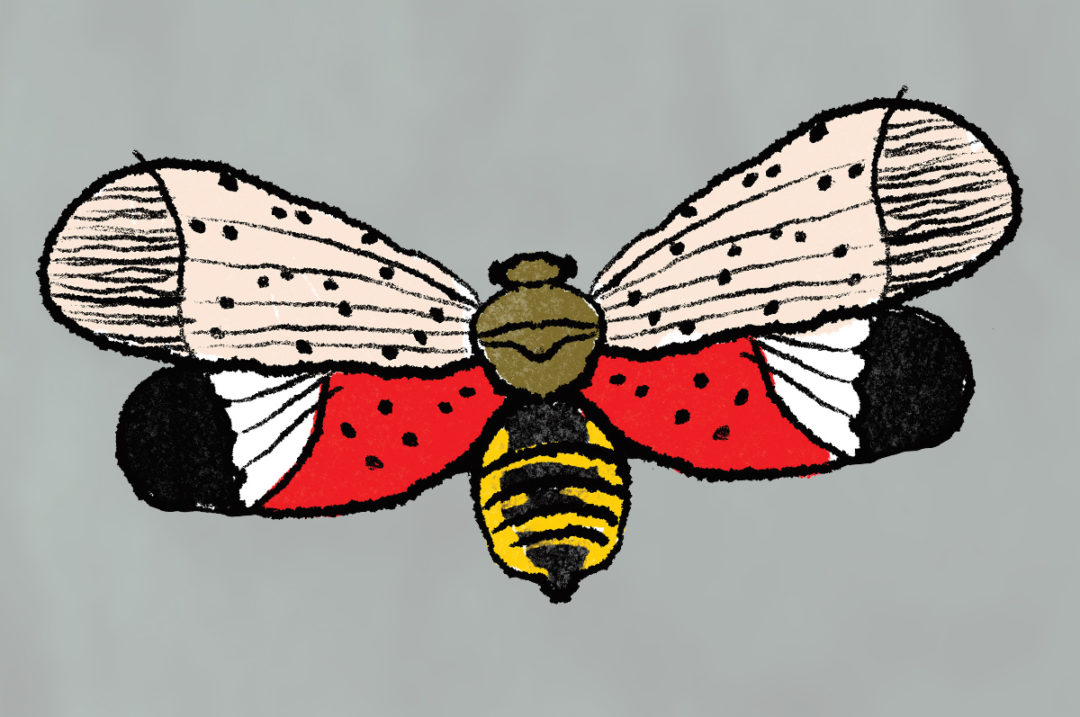Since their arrival in Berks County, Pennsylvania, in 2014, spotted lanternflies have developed quite a reputation for pestering people, threatening crops and damaging infrastructure. The invasive species has spread across at least 14 states and is not slowing down, despite numerous quarantine efforts.
Many people in affected states are already familiar with the brightly colored planthoppers and the call to address their rapidly growing numbers. News of their continued spread and impact on agriculture continues to prompt questions from producers across the country.
What are spotted lanternflies?
The spotted lanternfly is a planthopper commonly mistaken for a moth. Their life cycle consists of five stages, but the most recognizable is the adult stage, with its striking red and spotted wings. After hatching, the spotted lanternfly grows through four instars or wingless stages. The tiny nymphs are black with white spots until the final instar when their color changes to red with white spots. The life cycle of the spotted lanternfly lasts one year, with adults dying off in winter after laying eggs that overwinter and hatch the following spring.
Where did they come from?
The aptly nicknamed “hitchhiker insect” has a habit of hitching rides across state lines, despite quarantine efforts. In fact, many researchers believe that spotted lanternflies originally arrived in the U.S. alongside shipping materials traveling all the way from Asia.
Unlike other insect species that reproduce solely on organic matter, spotted lanternflies can lay egg masses on nearly any outdoor surface, from hay bales to tractors, pallets, buildings, fencing and trees. The egg masses, which contain anywhere from 30 to 50 eggs, are camouflaged and protected by a waxy substance, allowing them to overwinter and travel undetected.
The spotted lanternfly is native to China, India and Vietnam, but is considered an established invasive species in South Korea, Japan and the U.S. In each case, the accidental transport of spotted lanternfly egg masses makes the egg stage its most mobile.
So, besides its irritating and unsettling presence, why is the spotted lanternfly so dangerous?
Spotted lanternflies cannot bite, so they pose no physical threat to humans. Rather, their unique mouthpiece allows spotted lanternflies to pierce the bark of woody plants and feed on the sap inside. They show a strong preference for economically important plants and trees, as well as common ornamentals such as the invasive tree of heaven.
Spotted lanternflies consume more fluid from host plants than they can actually utilize. As a result, they excrete large amounts of honeydew, a sugary substance that is the perfect substrate for sooty mold and other harmful fungus. As the fungus spreads, it limits the plant’s ability to photosynthesize, hindering growth and decreasing yields.
When large groups of spotted lanternflies congregate in other places, the consequence is often the same. On top of the nuisance of wasps and pests, sooty mold growth challenges producers and threatens their bottom lines. Economists at Pennsylvania State University, where the spotted lanternfly first arrived, estimated that the spotted lanternfly could cause state losses of up to $324 million annually. Individual producers face yield losses and significant costs to reverse the damage of spotted lanternflies and honeydew on their property.
Despite common forage crops not being a preferred host plant for spotted lanternflies, forage producers still stand to lose out on profits as spotted lanternflies continue to spread. The secondary effects of spotted lanternflies impact forage producers' secondary sources of income as well as farm equipment and infrastructure. Even though spotted lanternflies might not feed directly on forage crops, honeydew excretion and fungus are still a concern for producers seeing large populations of spotted lanternflies. Forage producers may incur treatment and eradication costs, as well as repair costs for any fencing and infrastructure damaged by spotted lanternflies and fungal growth.
Where are they going?
Researchers believe that spotted lanternflies have the potential to continue to spread and impact agriculture across the country. The spotted lanternfly currently has few known natural predators in the U.S., so they can multiply unimpeded. Anecdotal evidence suggests that birds, spiders and praying mantises may prey on spotted lanternflies, but conclusive research is forthcoming.
States with high populations of spotted lanternflies have already seen the damage that can be done to economically important crops, and the problem continues to spread. Spotted lanternflies are already attracted to farms as a food source, and relationships between producers increase the likelihood that spotted lanternflies will travel to new farms. Like other producers, forage producers unwittingly transport spotted lanternflies or egg masses to other farms and buyers.
What can producers and individuals do to stop the spread of spotted lanternflies?
Researchers are hard at work trying to understand the most effective means of combatting the spotted lanternfly. There have been many suggestions for potential solutions to the spotted lanternfly problem – including introducing parasitic wasps, implementing new pesticide programs and using large-scale insect traps. The former would require thorough research before serious consideration.
For now, the USDA and state governments are calling on citizens to report spotted lanternfly sightings. Each state has a unique reporting system in an attempt to provide targeted responses. It is imperative that producers outside of the known range contact their state department of agriculture with any sightings.
There are several actions individuals can take to combat spotted lanternflies on their properties. Stomping out individual nymphs and lanternflies is a good start, but scouting farms and removing egg masses beginning in December are the most impactful actions producers and individuals can take to prevent the population from multiplying from year to year. Experts also advise checking vehicles for spotted lanternflies and egg masses before traveling to unaffected farms or regions.
Commercial and homemade traps are available and are effective at controlling spotted lanternflies on trees. However, when it comes to the tree of heaven, experts recommend removing the tree entirely if possible. Other situations may call for chemical control with insecticides.
How will the government address the spotted lanternfly?
The USDA Animal and Plant Health Inspection Service (APHIS) released its five-year plan to address the spotted lanternfly in June. The plan was developed by a group with representatives from APHIS, the National Association of State Departments of Agriculture and the National Plant Board.
The collaboration resulted in a strategy that will prioritize limiting the advancement of the spotted lanternfly to other regions, supporting new research into eradication methods, and establishing consistent messaging and education to producers around the country.
APHIS hopes to prevent human-assisted transport of spotted lanternflies, streamline public reporting, and utilize new research and management tools more fully under the collaborative five-year plan. The plan will enhance the capacity to respond to spotted lanternflies in high-risk areas. The collaboration will unite research, technology and resources to more effectively manage the spread. With time, the partnership should yield new information about host plants, control agents and management techniques.










